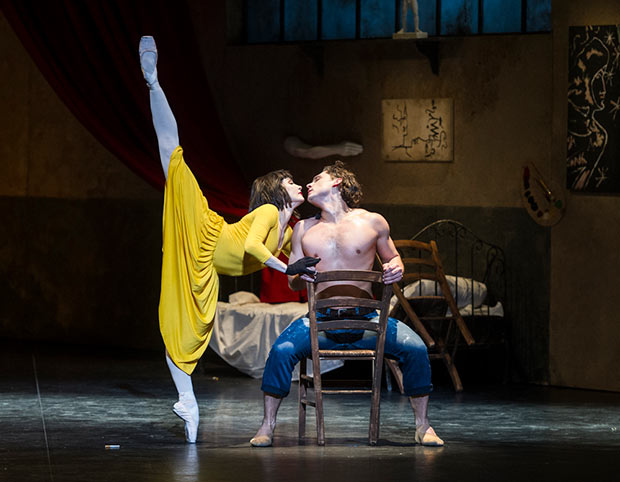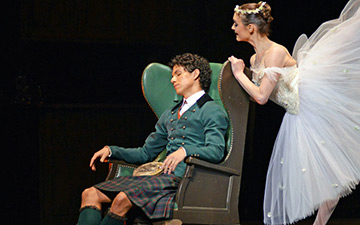
© Foteini Christofilopoulou. (Click image for larger version)
English National Ballet
Le Jeune Homme et la Mort, La Sylphide
★★★★✰
London, Coliseum
16 January 2018
Gallery of Le Jeune Homme et la Mort pictures by Foteini Christofilopoulou
www.ballet.org.uk
londoncoliseum.org
It’s almost five years since Tamara Rojo chose Ecstasy and Death for her first programme as Artistic Director of English National Ballet; thereby setting out her stall for exciting, challenging dance by great choreographers hitherto overlooked in the UK. Her opening triple bill had included Roland Petit’s Le Jeune Homme et la Mort – although the rights to perform it had been procured by Rojo’s predecessor, Wayne Eagling – in a production that was greatly enriched by the guest performance of Nicholas le Riche, as the uneasy young man trapped in a lonely garret.
One great privilege of Rojo being both director and dancer must be the opportunity to choose her own partners and this year’s returning guest is Ivan Vasiliev, presenting a very different image of Petit’s doomed young man from that which won Le Riche the National Dance Award for Outstanding Performance in Classical Dance, back in 2013. His man had the demeanour of a poet, sensitive and insecure; Vasiliev, on the other hand, essays the rough-and-ready, oil-and-Swarfega look of a motor mechanic; sweaty, bombastic, ill-at-ease. His is a very different reading but one that might not be a million miles away from that of the role’s creator, the highly unconventional Jean Babilée.

© Foteini Christofilopoulou. (Click image for larger version)
One point worth noting upfront is that Le Jeune Homme et la Mort is memorable largely due to the stunning designs of Georges Wakhévitch and Karinska’s costumes. The breath-taking reveal – in the work’s epilogue – of the post-war Parisian skyline with its flashing CITROEN lights superimposed on the Eifel Tower is one of modern ballet’s most striking images (although it lasts for barely a minute). So, why change the Young Man’s costume? Babilée wore old dungaree-style overalls; Vasiliev wears nothing but new jeans, styled in the distressed fashion of the 21st Century with the trouser hems finishing someway up the calf. It seemed strange and unnecessary to restyle just one element of the production’s original design ethos, as if Vasiliev’s Young Man had time-travelled back from 2018 to this 1946 setting.

© Foteini Christofilopoulou. (Click image for larger version)
What we lost in design was more than compensated for by the quality of performance. Vasiliev’s troubled young man was like a caged wild cat, alternating between lacklustre listlessness and frenzied athleticism. Rojo reprised her highly-charged and hugely effective cocktail of sexual predator, silent-movie femme fatale and grim reaper with all the expressiveness that this consummate dance actress can muster. It was a stunning, sensual performance by any measure.
Gavin Sutherland conducted the English National Ballet Philharmonic in an emphatic performance of Bach’s Passacaglia and Fugue in C Minor, in the lighter Respighi orchestration (rather than the more familiar Stokowski form) albeit with some fleeting, wincing moments from the brass section.
The ENB production of La Sylphide has been staged by three luminaries of Danish ballet – Frank Andersen, Eva Kloborg and Anne Marie Vessel Schlüter – and one would reasonably suppose that it is therefore as authentic to the Bournonville language, as possible, after the passage of 180 years. Earlier performances have attracted some criticism for not capturing the “Danish” style but, be that as it may, these dancers, at this performance, responded with a superb account of the ballet in the Bournonville way.

© Dave Morgan. (Click image for larger version)
This production certainly delves into some unchartered territory, at least for me, by naming James’s friends, as Bimse and Bumse, played with great comedy by James Streeter and Fabian Reimar. One minor but irritating element that was certainly not so authentic was the three uncredited bagpipers of Act 1, apparently playing the music for the highland reel, but “bopping” around as if they were merrily playing the saxophone in some kind of freestyle jazz jam, while high on the highland grain. Men in full Scottish dress, playing the bagpipes, generally do so whilst standing rigidly to attention!
Aitor Arrieta gave an excellent characterisation of James, differentiated from others I have seen in this season, by bringing a certain pompous demeanour to the character whose downfall is determined, not through his seduction by the ethereal beauty of the Sylph but by his arrogant and high-handed treatment of the witch, Madge, when she seeks warmth by the homestead fire. Arrieta danced his Bournonville solos (not, as some have said, in a grand pas de deux since this Romantic ballet came decades before that concept arose) with great accuracy and excitement. His Sylph was Alison McWhinney who has grown into the role over the past week, dancing with a serene beauty and gorgeous lines in her shimmering portrait of the woodland fairy inquisitively exploring the human world and finding love.

© Laurent Liotardo. (Click image for larger version)
Stina Quagebeur was terrific as Madge; Francesca Velicu, suitably vulnerable as Effie, the highland lassie betrayed by James and Henry Dowden made for a dour and dependable Gurn, the alternate bridegroom. I always feel that La Sylphide is somehow the most joyous of ballet’s tragedies and, here, this feeling was further enhanced by the orchestra’s performance of Løvenskiold’s luscious score, which was an absolute delight.

















You must be logged in to post a comment.